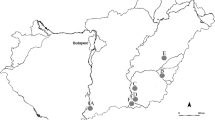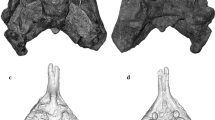Abstract
In March 1994, during excavation work for the construction of a motorway, a fragmented calvaria was discovered in the “Campo Grande” area near Ceprano, a town in southern Latium (Central Italy) about 55 miles from Rome. After reconstruction, the remain was recognized as belonging to aHomo erectus; it has been estimated that it goes back to the lowest middle Pleistocene. The calvaria exhibits two pathologic findings. The first is a congenital malformation of the sphenoidal sinus consisting in a deep, wide recess penetrating into the left greater wing as far as the sphenotemporal suture. The lesion was examined with the help of a cast whose features were compared with those described in some early and recent cases reported in the literature. The second finding is a healed, depressed fracture of the right brow ridge. The cause and mechanism of this lesion are discussed, and a mechanical approach has been used to provide information pertinent to the specific reason for the injury. The possibility that the hominid was butted by a large animal appears to be the most likely cause of the fracture.
Similar content being viewed by others
References
ALLSOP, D. L., WARNER C. Y., WILLE M. G., SCHNEIDER D. C. & NAHUM A. M., 1988. — Facial impact response-a comparison of the hybrid III dummy and human cadaver. Proceedings 32nd Stapp Car Crash Conference, Atlanta, Georgia, pp. 139–155. Warrendale P.A. publ.: Soc. of Automotive Engineers.
ASCENZI A., BIDDITTU I., CASSOLI P. F., SEGRE A. G. & SEGRE NALDINI E., 1996. — A calvarium of late Homo erectus from Ceprano. Italy Journal of Human Evolution, 31: 409–423.
ASCENZI A., BIDDITTU I., CASSOLI P. F., SEGRE A. G. & SEGRE NALDINI E., 1997. — Resti di cranio umano del pleistocene medio-inferiore a Ceprano. Proceedings of the Italian National Academy of Lincei 5.9; 8:39–67.
ASCENZI A. & SEGRE A. G., 1996. — A calvaria of a lower middle-pleistocene hominid from southern Latium. Proceedings of the 4th International Congress of Human Paleontology, Orce (Spain), September 4–7, 1995 (In press).
BASILONE P., 1975. — Datazione K-Ar dell’attività vulcanica dei monti Ernici (Latina). Società Italiana di Mineralogia e Petrologia, 31: 175–179.
CALVERT C. T. & CAIRNS H., 1942. — Discussion on injuries of frontal and ethmoid sinus. Proceedings of the Royal Society of Medicine, 35: 805–810.
COPE V. Z., 1917. — The internal structure of the sphenoidal sinus. Journal of Anatomy, 51: 127–136.
FORNASERI M., 1985. — Geochronology of volcanic rocks from Latium (Italy). Rendiconti Società Italiana di Mineralogia e Petrologia, 40: 73–106.
GADD C. W., NAHUM A. M., GATTS J. & DANFORD J.P., 1968. — Impact tolerance of skull and face. Proceedings 12th Stapp Car Crash Conference, pp. 308–316. Warrendale P.A. publ: Soc. of Automotive Engineers.
HAMPSON D., 1995. — Facial injury: a review of biomechanical studies and test procedures for facial injury assessment. Journal of Biomechanics, 28: 1–7.
KEITH A., 1927. — Report of the Galilee skull. In (F. Turville-Petre, ed.). Researches in Prehistoric Galillee. London; British School of Archaeology.
KEITH KNOWLES A., 1933. — Acute traumatic lesions. In (G. D. Hart, ed.). Disease in Ancient Man, pp. 61–83. Clarke Irvim, Agincourt, Ontario.
LANIGAN C.T. & STOELINGS P. J. W., 1980. — Fractures of the supraorbital rim. Journal of Oral Surgery, 38: 764–770.
MILLER S. H., LUNG R. J. & DAVIS T. S., 1978. — Management of fractures of the supraorbital rim. Journal of Trauma, 18: 507–512.
NYQUIST G. W., VAVANAUGH J. M., GOLDBERG S. J. & KING A. I., 1986. — Facial impact tolerance and response. Proceedings 30th Stapp Car Crash Conference. San Diego, California, pp 379–400. Warrendale P. A. publ.: Soc. of Automotive Engineers.
SCHLTZ R. C., 1970. — Supraorbital and glabellar fractures. Plastic and Reconstructive Surgery,45: 227–233.
SCHULTZ R. C., 1975. — Frontal sinus and supraorbital rim fractures from vehicle accidents. Clinical Plastic Surgery, 2: 93–106.
WEIDENREICH F., 1928. — Der Schaedelfund von Weimar-Ehringsdorf. Fischer G., Jena.
WEIDENREICH F., 1943. — The skull of Sinanthropus pekinensis; a comparative study on a primitive hominid skull. Palaeontologia Sinica, Ser. D; 10: 1–485.
WELLS C. P. B., 1977. — Disease of the maxillary sinus in antiquity. Medical and Biological Illustration, 27: 173–178.
Author information
Authors and Affiliations
Rights and permissions
About this article
Cite this article
Ascenzi, A., Benvenuti, A. & Segre, A.G. On the paleopathologic findings exhibited by the late Homo erectus of Ceprano, Italy. Hum. Evol. 12, 189–196 (1997). https://doi.org/10.1007/BF02438068
Received:
Accepted:
Issue Date:
DOI: https://doi.org/10.1007/BF02438068




